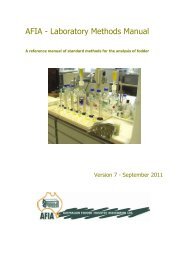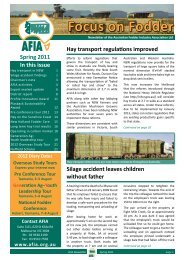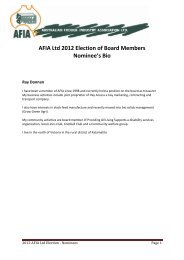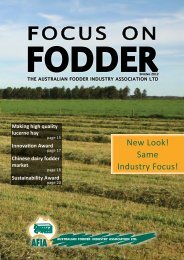NEWSLETTER - Australian Fodder Industry Association
NEWSLETTER - Australian Fodder Industry Association
NEWSLETTER - Australian Fodder Industry Association
Create successful ePaper yourself
Turn your PDF publications into a flip-book with our unique Google optimized e-Paper software.
Dairy Survey Reveals Hay Buying Behaviour<br />
A recent comprehensive survey of dairy<br />
farmers across the country revealed some<br />
interesting facts regarding buying behaviour<br />
of dairy farmers.<br />
The survey conducted by Dairy Australia<br />
asked the following questions:<br />
Sources<br />
With hay and silage which is fed to<br />
your cows, do you grow your own, buy in<br />
fodder from off farm, use both home grown<br />
and bought in or other?<br />
Where do you buy the majority of<br />
your hay and silage from? Is it direct from<br />
specialist hay growers, from other dairy<br />
farmers, from a feed merchant or other?<br />
When you purchase hay or silage, do<br />
you mainly buy it as required, buy and store<br />
in significant amounts on farm, forward<br />
contract for later delivery or other?<br />
all self<br />
grown<br />
50%<br />
hay and silage source<br />
not used<br />
2%<br />
both grown<br />
and<br />
purchased<br />
41%<br />
all<br />
purchased<br />
6%<br />
Answers<br />
• Approximately half the respondents<br />
(51%) who feed hay and silage grow it<br />
themselves, the others purchase from several<br />
sources, but mainly from specialist growers.<br />
• In WA, a high 67% grow their own<br />
hay or silage and 19% purchase from<br />
specialist hay growers. In contrast, 34% of<br />
Bega respondents grow their own and 48%<br />
purchase from specialist hay growers.<br />
• In an interesting result, 58% of<br />
respondents with extra-large herds grow<br />
their own hay or silage, a significant 14<br />
points higher than those with large herds<br />
(44%), but similar to those with small (51%)<br />
and medium herds (54%).<br />
Implications<br />
On most dairy farms, cows are fed at least<br />
some hay and/or silage which is grown on<br />
farm.<br />
These results highlight the importance of<br />
ensuring dairy farmers have considerable<br />
knowledge of how to maximise the feed<br />
value of both hay and silage.<br />
It is notable that respondents with herds of<br />
between 301 and 500 cows (the segment<br />
most likely to increase production) are the<br />
least likely to grow their own hay and silage.<br />
Purchase behaviour<br />
When you purchase grain or pellets,<br />
do you mainly buy it as required, buy and<br />
store in significant amounts on farm,<br />
forward contract for later delivery, use<br />
grains futures markets?<br />
When you purchase hay or silage, do<br />
you mainly buy it as required, buy and<br />
store in significant amounts on farm,<br />
forward contract for later delivery or other?<br />
Answers<br />
• Forty seven percent (47%) of<br />
respondents mainly purchase<br />
hay/silage as required, while 46%<br />
typically buy significant amounts and<br />
store it on farm.<br />
• Respondents from Tasmania (63%),<br />
nth Vic/Riverina, central/Murraylands<br />
SA (53%) and south/central NSW<br />
(51%) are the most likely to buy<br />
significant amounts of hay or silage<br />
and store it on farm.<br />
• Purchasing hay or silage by forward<br />
contract is significantly more common<br />
among respondents with x-large (19%)<br />
or large herds (16%) compared to<br />
small (6%) or medium herds (8%).<br />
AFIA Newsletter September 18







